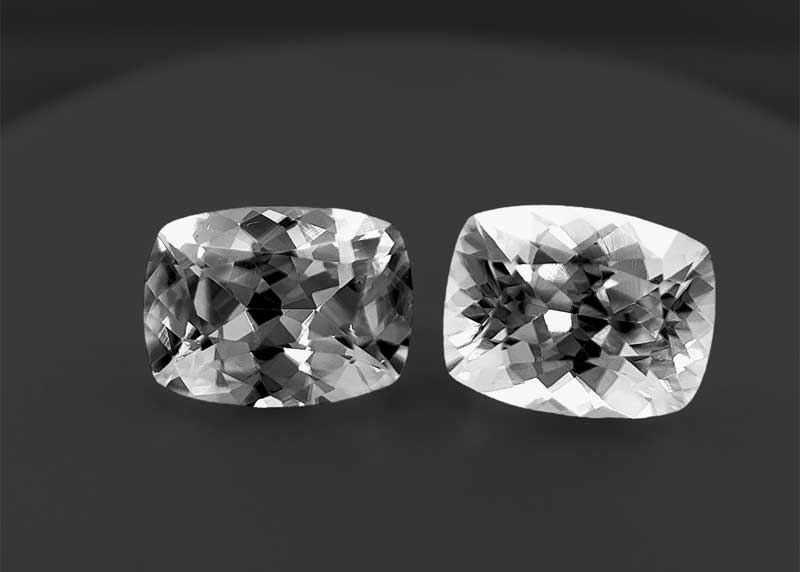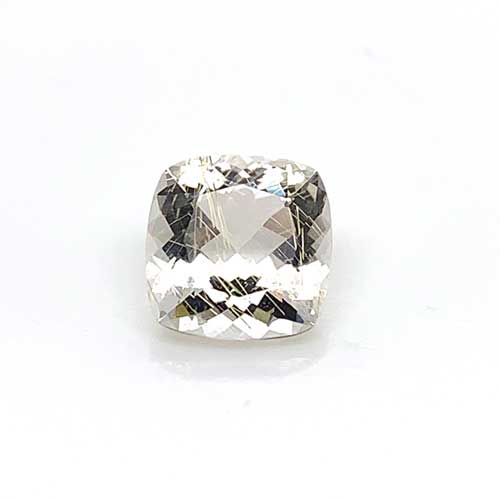Diamond replacements: Giving clients colourful colourless options
May 21, 2024
By Lauriane Lognay

A pair of colourless zircons, weighing 5.88 carats together (9 x 7 mm). Photos courtesy Rippana, Inc./Lauriane Lognay
"Diamonds are the forever gemstone, the eternal love symbol in marriage and the hardest gem there is. There is no doubt that diamonds play a large role in our business, but the facts are: Prices are dropping, people are hesitating, and synthetic diamonds are losing resell value. The current hesitancy to spend on diamonds, coupled with clients’ continued desire for a colourless diamond-like natural gem, point to one potential alternative: diamond replacements. While few gemstones can take the diamond’s place, natural gemstone substitutes remain within the realm of possibility for you and your customers.
When exploring natural diamond replacements, it’s important to consider a few crucial assets: hardness, dispersion, lustre, prices, possible sizes, and market availability. So, you must judge: What is a good option that is (i) in your client’s budget, (ii) hard enough for jewellery, and (iii) well known enough to appeal to customers? What looks good on a ring, and comes from our dear Mother Earth? If you cannot sell clients diamonds, and they do not want coloured gemstones, you have to think outside the box!
The market and the gem world are both full of surprises, and while there are hundreds of colourless gemstones, very few met the criteria for this article. With all the recommended assets in mind, the best possibilities would be the following:

A badly cut colourless sapphire from Sri Lanka, weighing 2.15 carats (9 x 7.2 mm). Once recut, it will have slight undertone of pink.
1) Colourless sapphire
Mohs hardness: 9
High lustre
No dispersion
Most expensive option
September birthstone
Colourless sapphire and near colourless sapphire with small undertones are easy enough to find. However, they are often not perfectly colourless. A little like the diamond, some colourless sapphires can have slight undertones and can be found in a variety of pale undertones, such as yellow, blue, or pink.
With a hardness of nine, and a great general lustre (though less lustrous than a diamond), the colourless sapphire is a very good choice for a happy couple looking to purchase natural gems and unwilling to turn to diamonds. Yet, keep in mind that acquiring colourless sapphires larger than three carats is often difficult, but still possible. It also lacks the dispersion of a diamond. Out of the four alternatives on this list, good quality colourless sapphire is the most pricey, though it is less expensive than diamonds of the same quality.
You May Also Like Greenland Ruby joins RJC

A trio of colourless topaz in square radiant cut (5 and 6 mm).
2) Colourless topaz
Mohs hardness: 8
Vitreous lustre
No dispersion
Not expensive
November birthstone
The hard and inexpensive nature of the colourless topaz makes it a good alternative to the diamond. With a hardness of eight, topaz can withstand much more than we give it credit for. Colourless topaz can easily be found in any size, with few to no inclusions—highlighting the gem as a good, inexpensive option for clients with big dreams, but little budgets. The lustre is lower than both the diamond and sapphire, but that is to be expected.

Colourless quartz cut in cushion, weight 8.54 carats (16 x 12 mm).
3) Colourless quartz
Mohs hardness: 7
Vitreous lustre
No dispersion
Least expensive option
April birthstone
Colourless quartz is the cheapest option out of the four named in this article. You can find it in large quantities, and in any quality (mostly flawless) or size. With a hardness of seven, it can withstand impacts and pressure well enough. Yet, it is not as hard as sapphire, topaz, or even zircon. Selling a quartz ring means you might see the ring again if a bad accident were to occur—but that could happen to any of the gemstones on this list, even the diamond. On the bright side, colourless quartz is easily replaceable.
Though the quartz has the lowest lustre and no dispersion, a well-cut quartz is worth more than its value in the eyes of clients who can pay for it! If your clients are daring, or want something different, colourless quartz also offers a multitude of inclusions and coloured patterns. You can have rutilated quartz (gold), strawberry quartz (red), or dumortierite quartz (blue). However, prices for these unique specimens are higher.

From left to right: sapphire, topaz, quartz, and zircon.
Colourless zircon
Mohs hardness: 6.5 to 7.5
Sub-adamantine lustre (good lustre)
Good dispersion
Medium prices
December birthstone
Colourless zircon is the only option that offers a decent dispersion of colour, a bit like a diamond. It also has a bright lustre to go with that dispersion. The stone has a good hardness, and you can find great quality in bigger sizes. Much like the colourless sapphire, there are also pieces of colourless zircon with a few undertones of colour.
You May Also Like Feel the heat: Hot jewellery styles for the fall/winter season
The biggest downside to zircon is people mistaking the gemstones for cubic zirconium, thereby considering zircon to be a synthetic gem. The two are completely separate stones: zircons are one of the oldest natural gems, while cubic zirconium are machine-made synthetic stones. Further, despite its hardness, zircon does not have the best tenacity. Zircon stones will suffer abrasions over time and must be treated in the same manner as softer stones like tanzanite. Though it is less expensive than sapphire, it is priced higher than topaz and quartz.
Diamonds will always have their place at the top of the jewellery chain, but we should never close our eyes to opportunities. As the market changes constantly, let’s adapt and grow with it!"
Lauriane Lognay is a fellow of the Gemmological Association of Great Britain (FGA), has an Applied Jewelry Professional (AJP) certificate from the Gemological Institute of America (GIA), studied gemmology in Montréal, and has won several awards. She is a gemstone dealer working with jewellers to help them decide on the best stones for their designs. Lognay is the owner of Rippana Inc., a Montréal-based company working in coloured gemstone, lapidary, and jewellery services. She can be reached at rippanainfo@gmail.com.
https://www.jewellerybusiness.com/featu ... nt=feature